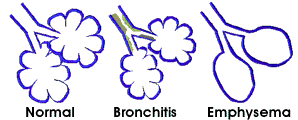All living animals must take in oxygen and get rid of carbon dioxide.
In
the vertebrates--animals with backbones--that get their oxygen
from
the air, both tasks are performed by special gas-exchange organs
called lungs. The lungs provide a place where oxygen can reach the
blood and carbon dioxide can be removed from it. They are equipped
with tubes and a bellows system for drawing in air from the outside,
while the pulmonary (Latin pulmo, "lung") veins and arteries
circulate
blood through from inside. The lungs also have a cleaning system that
traps, ejects, or destroys irritants and other harmful substances
that
travel in with the air.
In the simpler cold-blooded amphibians and reptiles, the lungs are
two balloonlike sacs. In active animals that require large amounts
of
oxygen, especially the warm-blooded birds and mammals, the lungs
are a spongy labyrinth of sacs that supply an enormous surface area
for the transfer of gases. In the adult human the total lung
surface, if
flattened out, would be larger than a badminton court, about 100
square yards (83 square meters).
Human lungs hold about four quarts (3.8 liters) of air. In quiet
breathing a person inhales about a pint of air with each breath.
When
very active, one may inhale six times as much by breathing more
deeply and rapidly to supply the increased oxygen demand.
The lung is composed of numerous sacs called
alveoli. It is on the inner surface of the alveoli
that oxygen is absorbed and enters the
bloodstream and carbon dioxide is released.
In the healthy lung, the alveoli receive
oxygen-rich air from the bronchial airways and
expand and contract like millions of small
balloons.
